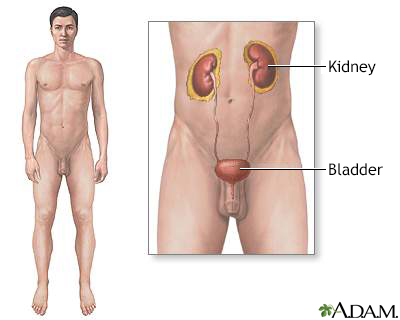PBG urine test
Porphobilinogen test; Porphyria - urine; PBG
Porphobilinogen (PBG) is one of several types of porphyrins found in your body. Porphyrins help form many important substances in the body. One of these is hemoglobin, the protein in red blood cells that carries oxygen in the blood. Porphyrins usually leave your body through urine or stools. If this process does not occur, porphyrins such as PBG can build up in your body.
This article describes the test to measure the amount of PBG in a urine sample.

The urinary system is made up of the kidneys, ureters, urethra and bladder.
How the Test is Performed
After you provide a urine sample, it is tested in the lab. This is called a random urine sample.
If needed, your health care provider may ask you to collect your urine at home over 24 hours. This is called a 24-hour urine sample. Your provider will tell you how to do this. Follow instructions exactly.
How to Prepare for the Test
Your provider may tell you to temporarily stop taking medicines that may affect the test results. Be sure to tell your provider about all the medicines you take. These include:
- Antibiotics and anti-fungal medicines
- Anti-anxiety medicines
- Birth control pills
- Diabetes medicines
- Pain medicines
- Sleep medicines
Never stop taking any medicine without first talking to your provider.
How the Test will Feel
This test involves only normal urination, and there is no discomfort.
Why the Test is Performed
This test may be done if your provider suspects porphyria or another disorder associated with an abnormal PBG level.
Normal Results
For a random urine sample, a negative test result is considered normal.
If the test is done on a 24-hour urine sample, the normal value is less than 4 milligrams per 24 hours (18 micromoles per 24 hours).
Normal value ranges may vary slightly among different lab. Some labs use different measurements or may test different specimens. Talk to your provider about the meaning of your specific test results.
What Abnormal Results Mean
An increased level of PBG in the urine may be due to:
- Hepatitis
- Lead poisoning
- Liver cancer
- Porphyria (several types)
Risks
There are no risks with this test.
References
American Porphyria Foundation website. Tests for porphyria diagnosis.
Fuller SJ, Wiley JS. Heme biosynthesis and its disorders: porphyrias and sideroblastic anemias. In: Hoffman R, Benz EJ, Silberstein LE, et al, eds. Hematology: Basic Principles and Practice. 8th ed. Philadelphia, PA: Elsevier; 2023:chap 39.
Hift RJ. The porphyrias. In: Goldman L, Cooney KA, eds. Goldman-Cecil Medicine. 27th ed. Philadelphia, PA: Elsevier; 2024:chap 194.
Version Info
Last reviewed on: 2/3/2025
Reviewed by: Warren Brenner, MD, Oncologist, Lynn Cancer Institute, Boca Raton, FL. Review provided by VeriMed Healthcare Network. Also reviewed by David C. Dugdale, MD, Medical Director, Brenda Conaway, Editorial Director, and the A.D.A.M. Editorial team.
